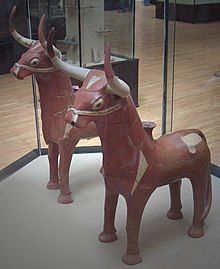Animal vessel

Animal vessels are vessels in the shape of animals that were used for ritual purposes in the ancient Orient . They are often referred to as rhyton due to their shape . They are particularly common in Anatolia and Syria , with bull and deer vessels in Anatolia and lion vessels in Syria being more common. They were used for libations , whereby there was a relationship between animal species and revered deity.
Historical development
The oldest animal vessels come from Hacılar Höyük in southwestern Turkey, where two Neolithic vessels in the shape of a deer and a boar were found (approx. 5600 BC). From the Western Anatolian Yortan culture (3500–2600 BC) vessels in the shape of a lion, bull, boar and hare are known. A large number of different animal vessels of high artistic quality come from Kültepe (20th – 18th centuries BC) and can be ascribed to the Hittites . Animal vessels were also used in the neighboring Hattic area at that time, as is shown by finds from Alışar Höyük , Boğazkale , Alaca Höyük and Eskiyapar . In Hittite cult texts from the 16th to the 13th century BC Animal vessels are often mentioned and also described, so that their function in the cult is well known. The descriptive texts and the archaeological finds are in good agreement.
to form
Animal vessels can come in three forms, namely animals standing on all fours, animals lying down, sometimes consisting only of the front body, and animal heads. There are also protomes and vessels that are decorated with animals or animal heads. Domestic animals, wild animals and mythical creatures are depicted : lion, leopard, deer, wild bull, bull, calf, horse, ram, mountain sheep, wild boar, boar, hare and birds, especially eagles and partridges, and more rarely also hedgehogs, turtles, snails or fish. Some of the animal vessels mentioned in texts cannot be precisely determined; the awiti vessel is likely to be a winged lion, the šaša vessel a gazelle or wild goat and the zinzapu vessel a pigeon. Such animal vessels are often paired, whereby both animals can be represented identically or differently. For example, a pair of eagles was found in Kültepe, one of which is holding a hare in its claws, another pair from the same place consists of a sleeping and a waking dog.
These cult vessels can consist of painted ceramics, they were also made of bronze, silver, gold, and iron, which was even more valuable in the Bronze Age, as well as valuable stones such as lapis lazuli or obsidian , and more rarely also from wood. They usually only have one opening.
use
The animal vessels are usually referred to in Hittite texts with the Akkadogram BIBRÛ , which is often translated as "Rhyton". The Hittite word was ḫalwani , the Hurrian ḫurubbi . They were filled with alcoholic drinks, often called wine, tawal beer and walḫi drink, which were either drunk directly from the animal vessel or poured into smaller drinking bowls beforehand. The drink could also be poured on the floor as a sacrifice before the deity. A typical Hittite custom was "drinking a deity".
An animal vessel could also represent a deity. The image of the weather god of Liḫzina was described as a bull rhyton standing on all fours. Bull vessels were mostly used to worship a weather deity , and there are written records of bull vessels for the weather god of Zippalanda . In contrast, a ram vessel was used in the festival of the Palaean weather god Ziparwa and a mountain sheep vessel has been handed down for the “weather god of the sky”. Deer vessels are attested to the cult of the patron god of the hallway . One of the most valuable animal vessels found is the deer hyton from the Norbert Schimmel collection , consecrated to the stag god . The " patron god of the lance ", however, was worshiped with a boar vessel. Lion vessels were used for warlike deities, for example Ištar and Zababa , the latter's cult vessel was described as a lion standing on all fours. The awiti -Gefäß, probably a winged lion, was in the cult of šauška used of Nineveh and the Hattic deity Waḫiši. Queen Puduḫepa promised the plague god Yarri a horse vessel and wagon. Finally, the eagle was part of the cult of mountain gods.
literature
- Volkert Haas : History of the Hittite religion (= Handbook of Oriental Studies . Volume 1.15). Brill, Leiden 1994, ISBN 978-9-004-09799-5 .
- Oguz Soysal, Rainer M. Czichon: Animal vessel. In: Michael P. Streck (ed.): Reallexikon der Assyriologie und Vorderasiatischen Aräologie . Volume 14, Walter de Gruyter, Berlin / Boston 2014–2016, ISBN 978-3-11-034659-6 , pp. 1–6.


